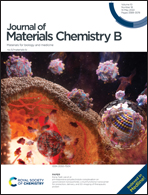Synthesis of tetraphenylethene-based D–A conjugated molecules with near-infrared AIE features, and their application in photodynamic therapy†
Abstract
Herein, five aggregation-induced emission (AIE) photosensitizers (PSs) with D–π–A structures are smoothly designed and synthesized through donor and acceptor engineering. The photophysical properties and theoretical calculation results show that the synergistic effect of methoxy substituted tetraphenylethene (MTPE), 3,4-ethylenedioxythiophene can enhance the intramolecular charge transfer effect (ICT), and promote the intersystem crossing (ISC) process of the whole molecule. In these AIE-PSs, the best-performing AIE-PS (MTPE-DT-Py) has bright NIR (740 nm) emission, the highest 1O2 generation efficiency (5.9-fold that of Rose Bengal) and efficient mitochondrial targeting ability. Subsequently, PDT anti-cancer and anti-bacterial experiments indicate that MTPE-DT-Py could obviously target mitochondria and kill breast cancer cells (MCF-7), and selectively inactivate S. aureus (G(+)) under white light irradiation. This work mainly proposes a practical design strategy for high effect AIE-PSs and provides more excellent candidates for fluorescence imaging-guided photodynamic therapy.



 Please wait while we load your content...
Please wait while we load your content...